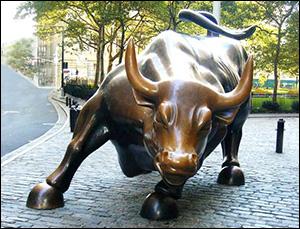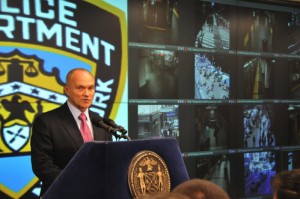Despite Eight Ongoing Criminal/Civil Investigations of JPMorgan, the Bank’s a Law Enforcement Partner With the NYPD
By Pam Martens: November 4, 2013Nothing reveals the incestuous, one-percent-mindset that New York City Mayor Michael Bloomberg and Police Commissioner Raymond Kelly have with Wall Street than the next to last photo at this link. The photo shows an employee of U.S. Attorney General Eric Holder’s number one target for financial fraud investigations, JPMorgan Chase, working inside a high security spy center in Lower Manhattan to — wait for it — help the New York City Police Department catch crooks.
While most law enforcement bodies around the U.S. would instantly weed out serial wrongdoers as job hires, Bloomberg and Kelly have created an art form out of joint policing ventures with Wall Street, operating both a rent-a-cop program with Wall Street as well as pumping at least $150 million of taxpayer money into the Lower Manhattan Security Coordination Center where Wall Street employees sit elbow to elbow with NYPD officers.
Under some Orwellian concept of citizen surveillance, the very Wall Street banks that proved they were a far greater threat to the United States than any foreign terrorist when they collapsed the Nation’s financial system in 2008, are part of a joint venture with the NYPD to use high-tech spy equipment to monitor the comings and goings of citizens in the streets of Manhattan – the majority of which, unlike Wall Street, are law abiding citizens.
Last week, JPMorgan Chase revealed in a filing with the Securities and Exchange Commission that it is under eight separate investigations by the U.S. Department of Justice. Some of the investigations involve potentially criminal matters ranging from allegations of hiring well-connected family members to get business in Asia; turning a blind eye to fraudulent transactions that Bernard Madoff ran through his business bank account at JPMorgan; rigging the Libor interest rate index; manipulating energy trading markets; gambling in London with insured deposits (London Whale episode); to improper credit derivatives and mortgage bond sales.
One of the most serious crimes for which JPMorgan is under investigation is the decades-long Ponzi scheme perpetrated by Bernard Madoff, which stole $17 billion in actual cash from thousands of investors while producing account statements showing the fictitious portfolios had grown to $64 billion. The fraud left hundreds of families destitute or forced to move in with children.
Outside of Madoff and his employees, no one had a better birds-eye view of this operation than JPMorgan Chase, the bank where Madoff held his business bank account for 22 years. According to lawsuits filed by the Trustee handling the Madoff recovery funds, Irving Picard, JPMorgan knew that Madoff was engaged in an investment advisory business for a broad array of customers but the Madoff bank account that JPMorgan Chase oversaw never showed a payment going to clear or process a stock trade.
Read More Here
..........
Wall Street’s Biggest Banks Had a Trading Scheme With Madoff
By Pam Martens: October 30, 2013 The
trial of five former employees of Bernard Madoff’s Ponzi operation is
currently playing out in Manhattan as the U.S. Justice Department weighs
bringing charges against JPMorgan Chase, where Madoff had his primary
business banking account, for ignoring flashing red lights that a fraud
was taking place.
The
trial of five former employees of Bernard Madoff’s Ponzi operation is
currently playing out in Manhattan as the U.S. Justice Department weighs
bringing charges against JPMorgan Chase, where Madoff had his primary
business banking account, for ignoring flashing red lights that a fraud
was taking place.According to lawsuits filed by Irving Picard, the Trustee handling the Madoff recovery fund, JPMorgan knew that Madoff was supposed to be engaged in managing stock portfolios for hundreds of clients. JPMorgan even created structured investments that allowed investors to make leveraged bets on the returns achieved by Madoff. But the Madoff business bank account that JPMorgan Chase oversaw, showed billions of dollars in cash being wired in and out but no payments ever going to any party engaged in processing or clearing a stock trade. Under Wall Street’s Know Your Customer Rule, the activity in the account should have been reported to U.S. regulators because it was completely incompatible with transactions that would be happening in a legitimate investment advisory account.
On October 28, 2008, less than two months before the Madoff Ponzi scheme collapsed following a confession by Madoff, JPMorgan finally did reveal its suspicions to a regulator that Madoff was running a fraud – to the Serious Organized Crime Agency. That regulator is based in the United Kingdom. According to Picard, JPMorgan never reported its suspicions to U.S. authorities.
But there are four other major Wall Street firms and their high-priced lawyers who have some explaining to do. According to prosecutors trying the current case against the five former employees, Madoff was funneling tens of millions of dollars that he was stealing from his investment advisory clients into his broker-dealer operation. Madoff has heretofore said this was a legitimate business. One such check for $31 million was dated December 28, 1999.
That was a little more than three months after Madoff started a business with four of the biggest names on Wall Street, effectively putting these primary dealers to the U.S. government’s Treasury auctions in business with the biggest financial felon in U.S. history.
On September 14, 1999, Citigroup’s Smith Barney, Morgan Stanley, Merrill Lynch and Goldman Sachs partnered with Madoff to compete with the New York Stock Exchange in a venture called Primex Trading. When Wall Street behemoths create a joint venture with a much smaller firm like Madoff’s, it would be expected that the top law firms on Wall Street would have been crawling all over its books and conducting a thorough due diligence.(Major European banks were harmed in the Madoff collapse. No major Wall Street bank had any serious exposure.)
Madoff had purchased the rights to a new technology called Financial Auction Network (FAN) created by Christopher Keith, a 17-year veteran of technology creation at the New York Stock Exchange (NYSE). Keith had retired from the NYSE and started a technology think tank in lower Manhattan in the early 1990s called Exchange Lab. FAN was one of the early technology offerings and the rights to develop it were bought by Madoff, ostensibly with stolen customer funds it now appears. The firm that emerged was Primex Trading, a division of Primex Holdings.
Read More here
..........









No comments:
Post a Comment
Hello and thank you for visiting my blog. Please share your thoughts and leave a comment :)